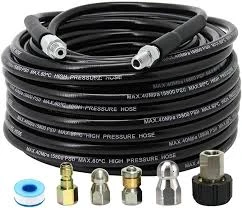Common Signs of a Failing Power Steering Hose in Your Vehicle
Understanding Bad Power Steering Hose Symptoms What You Need to Know
The power steering system in your vehicle is essential for providing a smooth and controlled driving experience. One critical component of this system is the power steering hose, which is responsible for transporting hydraulic fluid to and from the power steering pump. When this hose begins to fail, it can lead to a range of symptoms that may affect your vehicle's handling and safety. Recognizing these symptoms early can save you from extensive repairs and ensure your vehicle remains safe on the road.
1. Whining Noises A Telling Sound
One of the first signs of a bad power steering hose is a whining noise when you turn the steering wheel. This sound typically indicates a problem with the hydraulic fluid flow, often caused by a leak or blockage in the hose. If you hear a whining or groaning sound that intensifies during sharp turns or when the vehicle is idle, it's essential to investigate further. Ignoring this symptom can lead to more significant issues, including straining the power steering pump.
2. Fluid Leaks A Visible Red Flag
Another major symptom to watch for is fluid leaks around the power steering hose. The hydraulic fluid used in the power steering system is typically a reddish color, making it easier to identify. If you notice puddles or spots of this fluid underneath your vehicle or along the power steering components, it may indicate a damaged or cracked hose. Regularly checking your driveway and the area around your vehicle for fluid leaks can help catch this issue before it escalates.
3. Difficulty Steering A Crucial Warning
bad power steering hose symptoms

Perhaps the most concerning symptom of a failing power steering hose is difficulty steering. If you find yourself struggling to turn the steering wheel, especially at low speeds or while parked, there may be an issue with the power steering fluid pressure. A compromised hose can lead to reduced fluid flow, making it harder to maneuver the vehicle. If left unaddressed, this could result in complete power steering failure, which not only affects your driving experience but also poses a major safety risk.
4. Steering Wheel Vibration An Unsteady Ride
Experiencing vibrations or a feeling of looseness in the steering wheel can also signal trouble with the power steering hose. This symptom often indicates air bubbles or contaminants in the hydraulic fluid caused by a damaged hose. If you notice these vibrations becoming more pronounced, it's critical to have your vehicle inspected. Ignoring steering wheel vibrations may lead to a decline in overall steering performance and increased wear on other steering components.
5. Warning Light on the Dashboard A Tech-Savvy Alert
Modern vehicles are equipped with an array of sensors and warning lights to alert drivers to potential issues. If a warning light related to the power steering system illuminates on your dashboard, it is important not to ignore it. This could be a sign of low fluid levels caused by a leak in the power steering hose or other related issues. Checking your owner's manual can provide specific information regarding what the warning lights mean and what action to take.
Conclusion Take Action Early
Understanding the symptoms of a bad power steering hose is essential for any vehicle owner. Early detection and intervention can prevent further damage to your power steering system and enhance your driving safety. If you experience any of the symptoms discussed – whining noises, fluid leaks, difficulty steering, steering wheel vibrations, or dashboard warning lights – it is advisable to consult a qualified mechanic. Regular vehicle maintenance can also help to identify potential issues before they become serious problems, ensuring your power steering system remains in top condition for a smooth and safe driving experience.
-
Ultimate Spiral Protection for Hoses & CablesNewsJun.26,2025
-
The Ultimate Quick-Connect Solutions for Every NeedNewsJun.26,2025
-
SAE J1401 Brake Hose: Reliable Choice for Safe BrakingNewsJun.26,2025
-
Reliable J2064 A/C Hoses for Real-World Cooling NeedsNewsJun.26,2025
-
Heavy-Duty Sewer Jetting Hoses Built to LastNewsJun.26,2025
-
Fix Power Steering Tube Leaks Fast – Durable & Affordable SolutionNewsJun.26,2025

